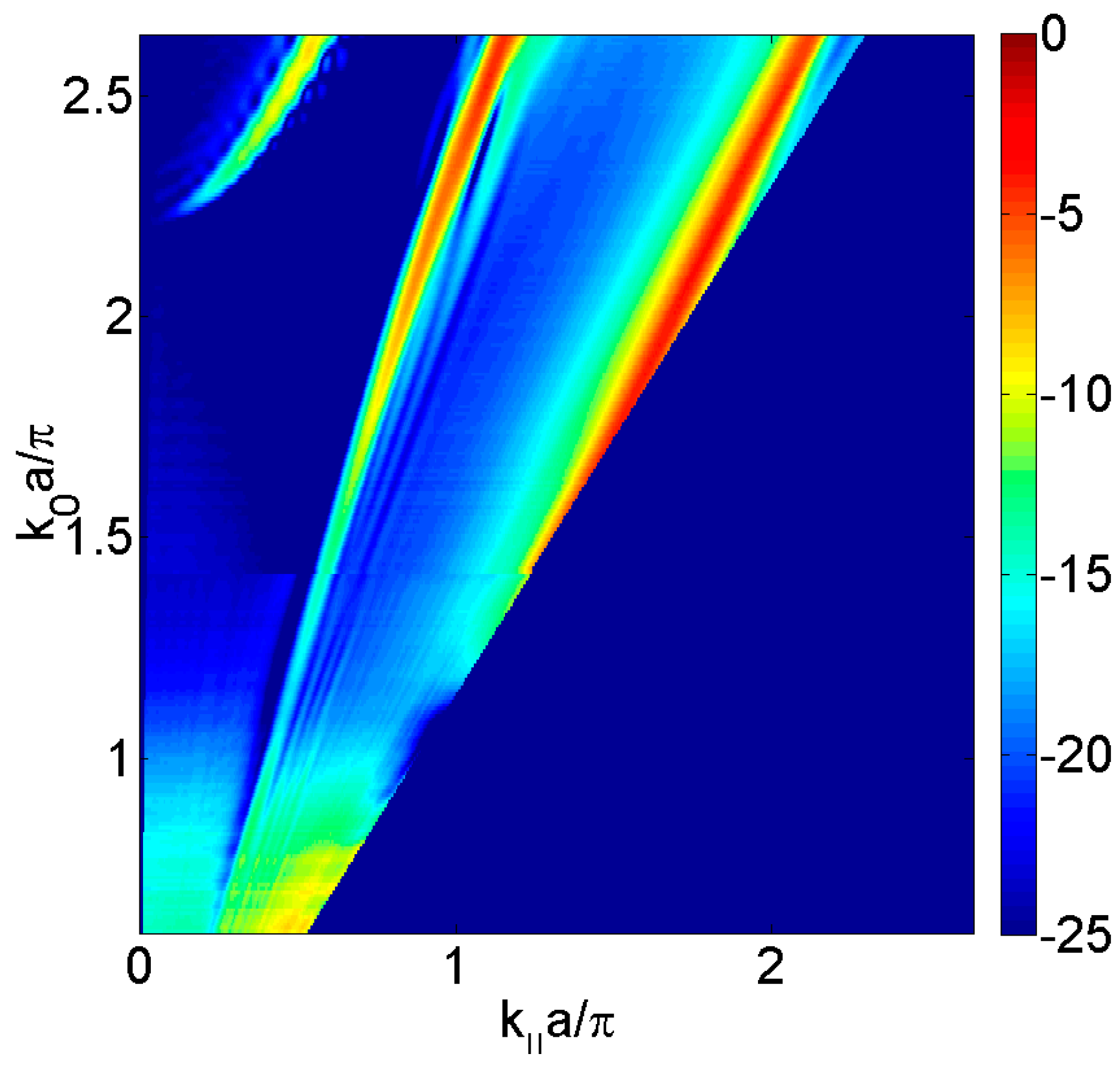Experimental Ultrasound Transmission through Fluid-Solid and Air-Solid Phononic Plates
Abstract
:1. Introduction
2. Materials and Methods
3. Results and Discussion
4. Conclusions
Acknowledgments
Author Contributions
Conflicts of Interest
References
- Rayleigh, L. The Theory of Sound, 2nd ed.; Courier Dover Publications: New York, NY, USA, 1945; Volume 2, p. 89. [Google Scholar]
- Miyashita, T. Sonic crystals and sonic waveguides. Meas. Sci. Technol. 2005, 16, R47–R63. [Google Scholar] [CrossRef]
- Sigalas, M.; Kushwaha, M.S.; Economou, E.N.; Kafesaki, M.; Psarobas, I.E.; Steurer, W. Classical vibrational modes in photonic lattices: Theory and experiment. Z. Kristallogr. 2005, 220, 765–809. [Google Scholar]
- Chen, J.-J.; Qin, B.; Cheng, J.C. Complete band gaps for Lamb waves in cubic thin plates with periodically placed inclusions. Chin. Phys. Lett. 2005, 22, 1706–1708. [Google Scholar]
- Khelif, A.; Aoubiza, B.; Mohammadi, S.; Adibi, A.; Laude, V. Complete band gaps in two-dimensional phononic crystal slabs. Phys. Rev. E 2006, 74, 045510. [Google Scholar] [CrossRef] [PubMed]
- Vasseur, J.O.; Deymier, P.A.; Djafari-Rouhani, B.; Pennec, Y.; Hladky-Hennion, A.C. Absolute forbidden bands and waveguiding in two-dimensional phononic crystal plates. Phys. Rev. B 2008, 77, 085415. [Google Scholar] [CrossRef]
- Zhang, X.; Jackson, T.; Lafond, E.; Deymier, P.; Vasseur, J. Evidence of surface acoustic wave band gaps in the phononic crystals created on thin plates. Appl. Phys. Lett. 2006, 88, 041911. [Google Scholar] [CrossRef]
- Brunet, T.; Vasseur, J.; Bonello, B.; Djafari-Rouhani, B.; Hladky-Hennion, A.C. Lamb waves in phononic crystal slabs with square or rectangular symmetries. J. Appl. Phys. 2008, 104, 043506. [Google Scholar] [CrossRef]
- Mohammadi, S.; Eftekhar, A.A.; Khelif, A.; Hunt, W.D.; Adibi, A. Evidence of large high frequency complete phononic band gaps in silicon phononic crystal plates. Appl. Phys. Lett. 2008, 92, 221905. [Google Scholar] [CrossRef]
- Lin, C.-M.; Hsu, J.-C.; Senesky, D.G.; Pisano, A.P. Anchor loss reduction in AlN Lamb wave resonators using phononic crystal strip tethers. Proc. IEEE Int. Freq. Control Symp. 2014. [Google Scholar] [CrossRef]
- Ebbesen, T.W.; Lezec, H.J.; Ghaemi, H.F.; Thio, T.; Wolf, P.A. Extraordinary optical transmission through subwavelength hole arrays. Nature 1998, 391, 667–669. [Google Scholar] [CrossRef]
- Garcia-Vidal, F.J.; Martin-Moreno, L.; Ebbesen, T.W.; Kuipers, L. Light passing through subwavelength apertures. Rev. Mod. Phys. 2010, 82, 729–787. [Google Scholar] [CrossRef] [Green Version]
- Zhou, L.; Kriegmann, G.A. Complete transmission through a periodically perforated rigid slab. J. Acoust. Soc. Am. 2007, 121, 3288–3299. [Google Scholar] [CrossRef] [PubMed]
- Lu, M.; Liu, X.; Feng, L.; Li, J.; Huang, C.; Chen, Y.; Zhu, Y.; Zhu, S.; Ming, N. Extraordinary acoustic transmission through a 1D grating with very narrow apertures. Phys. Rev. Lett. 2007, 99, 174301. [Google Scholar] [CrossRef] [PubMed]
- Hou, B.; Mei, J.; Ke, M.; Wen, W.; Liu, Z.; Shi, J.; Sheng, P. Tuning Fabry-Perot resonances via diffraction evanescent waves. Phys. Rev. B 2007, 76, 054303. [Google Scholar] [CrossRef]
- Wood, R.W. On a remarkable case of uneven light in a diffraction grating. Philos. Mag. 1902, 4, 396–402. [Google Scholar] [CrossRef]
- Christensen, J.; Martin-Moreno, L.; Garcia-Vidal, F.J. Theory of resonant acoustic transmission subwavelength apertures. Phys. Rev. Lett. 2008, 101, 014301. [Google Scholar] [CrossRef] [PubMed]
- He, Z.; Jia, H.; Qiu, C.; Ye, Y.; Hao, R.; Ke, M.; Liu, Z. Nonleaky surface acoustic waves on a textured rigid surface. Phys. Rev. B 2011, 83, 132101. [Google Scholar] [CrossRef]
- Estrada, H.; Candelas, P.; Uris, A.; Belmar, F.; Garcia de Abajo, F.J.; Meseguer, F. Extraordinary sound screening in perforated plates. Phys. Rev. Lett. 2008, 101, 084302. [Google Scholar] [CrossRef] [PubMed]
- Estrada, H.; Candelas, P.; Uris, A.; Belmar, F.; Garcia de Abajo, F.J.; Meseguer, F. Influence of lattice symmetry on ultrasound transmission through plates with subwavelength aperture arrays. Appl. Phys. Lett. 2009, 95, 051906. [Google Scholar] [CrossRef]
- Estrada, H.; Garcia de Abajo, F.J.; Candelas, P.; Uris, A.; Belmar, F.; Meseguer, F. Angle-dependent ultrasonic transmission through plates with subwavelength hole arrays. Phys. Rev. Lett. 2009, 102, 144301. [Google Scholar] [CrossRef] [PubMed]
- He, Z.; Jia, H.; Qiu, C.; Peng, S.; Mei, X.; Cai, F.; Peng, P.; Ke, M.; Liu, Z. Acoustic transmission enhancement through a periodically structured stiff plate without any opening. Phys. Rev. Lett. 2010, 105, 074301. [Google Scholar] [CrossRef] [PubMed]
- Estrada, H.; Candelas, P.; Uris, A.; Belmar, F.; Meseguer, F.; Garcia de Abajo, F.J. Sound transmission through perforated plates with subwavelength hole arrays: A rigid-solid model. Wave Motion 2011, 48, 235–242. [Google Scholar] [CrossRef]








© 2016 by the authors; licensee MDPI, Basel, Switzerland. This article is an open access article distributed under the terms and conditions of the Creative Commons Attribution (CC-BY) license (http://creativecommons.org/licenses/by/4.0/).
Share and Cite
Gómez-Lozano, V.; Rubio, C.; Candelas, P.; Uris, A.; Belmar, F. Experimental Ultrasound Transmission through Fluid-Solid and Air-Solid Phononic Plates. Materials 2016, 9, 453. https://doi.org/10.3390/ma9060453
Gómez-Lozano V, Rubio C, Candelas P, Uris A, Belmar F. Experimental Ultrasound Transmission through Fluid-Solid and Air-Solid Phononic Plates. Materials. 2016; 9(6):453. https://doi.org/10.3390/ma9060453
Chicago/Turabian StyleGómez-Lozano, Vicente, Constanza Rubio, Pilar Candelas, Antonio Uris, and Francisco Belmar. 2016. "Experimental Ultrasound Transmission through Fluid-Solid and Air-Solid Phononic Plates" Materials 9, no. 6: 453. https://doi.org/10.3390/ma9060453





